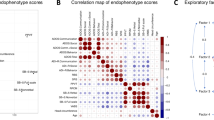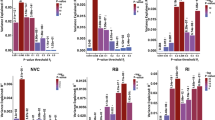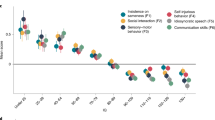Abstract
Almost all genetic risk factors for autism spectrum disorders (ASDs) can be found in the general population, but the effects of this risk are unclear in people not ascertained for neuropsychiatric symptoms. Using several large ASD consortium and population-based resources (total n > 38,000), we find genome-wide genetic links between ASDs and typical variation in social behavior and adaptive functioning. This finding is evidenced through both LD score correlation and de novo variant analysis, indicating that multiple types of genetic risk for ASDs influence a continuum of behavioral and developmental traits, the severe tail of which can result in diagnosis with an ASD or other neuropsychiatric disorder. A continuum model should inform the design and interpretation of studies of neuropsychiatric disease biology.
This is a preview of subscription content, access via your institution
Access options
Subscribe to this journal
Receive 12 print issues and online access
$209.00 per year
only $17.42 per issue
Buy this article
- Purchase on Springer Link
- Instant access to full article PDF
Prices may be subject to local taxes which are calculated during checkout



Similar content being viewed by others
References
Gaugler, T. et al. Most genetic risk for autism resides with common variation. Nat. Genet. 46, 881–885 (2014).
Krumm, N. et al. Excess of rare, inherited truncating mutations in autism. Nat. Genet. 47, 582–588 (2015).
Cross-Disorder Group of the Psychiatric Genomics Consortium. Genetic relationship between five psychiatric disorders estimated from genome-wide SNPs. Nat. Genet. 45, 984–994 (2013).
Bulik-Sullivan, B.K. et al. LD Score regression distinguishes confounding from polygenicity in genome-wide association studies. Nat. Genet. 47, 291–295 (2015).
De Rubeis, S. et al. Synaptic, transcriptional and chromatin genes disrupted in autism. Nature 515, 209–215 (2014).
Iossifov, I. et al. The contribution of de novo coding mutations to autism spectrum disorder. Nature 515, 216–221 (2014).
Hanson, E. et al. The cognitive and behavioral phenotype of the 16p11.2 deletion in a clinically ascertained population. Biol. Psychiatry 77, 785–793 (2015).
Plomin, R., Haworth, C.M. & Davis, O.S. Common disorders are quantitative traits. Nat. Rev. Genet. 10, 872–878 (2009).
Kanner, L. Autistic disturbances of affective contact. Nervous Child 2, 217–250 (1943).
Constantino, J.N., Zhang, Y., Frazier, T., Abbacchi, A.M. & Law, P. Sibling recurrence and the genetic epidemiology of autism. Am. J. Psychiatry 167, 1349–1356 (2010).
Robinson, E.B. et al. Evidence that autistic traits show the same etiology in the general population and at the quantitative extremes (5%, 2.5%, and 1%). Arch. Gen. Psychiatry 68, 1113–1121 (2011).
Lundström, S. et al. Autism spectrum disorders and autistic like traits: similar etiology in the extreme end and the normal variation. Arch. Gen. Psychiatry 69, 46–52 (2012).
Ronald, A. et al. Genetic heterogeneity between the three components of the autism spectrum: a twin study. J. Am. Acad. Child Adolesc. Psychiatry 45, 691–699 (2006).
Stefansson, H. et al. CNVs conferring risk of autism or schizophrenia affect cognition in controls. Nature 505, 361–366 (2014).
Männik, K. et al. Copy number variations and cognitive phenotypes in unselected populations. J. Am. Med. Assoc. 313, 2044–2054 (2015).
Moreno-De-Luca, A. et al. The role of parental cognitive, behavioral, and motor profiles in clinical variability in individuals with chromosome 16p11.2 deletions. JAMA Psychiatry 72, 119–126 (2015).
Yang, J., Lee, S.H., Goddard, M.E. & Visscher, P.M. GCTA: a tool for genome-wide complex trait analysis. Am. J. Hum. Genet. 88, 76–82 (2011).
Bulik-Sullivan, B. et al. An atlas of genetic correlations across human diseases and traits. Nat. Genet. 47, 1236–1241 (2015).
Boyd, A. et al. Cohort Profile: the 'children of the 90s'—the index offspring of the Avon Longitudinal Study of Parents and Children. Int. J. Epidemiol. 42, 111–127 (2013).
Fraser, A. et al. Cohort Profile: the Avon Longitudinal Study of Parents and Children: ALSPAC mothers cohort. Int. J. Epidemiol. 42, 97–110 (2013).
Skuse, D.H., Mandy, W.P. & Scourfield, J. Measuring autistic traits: heritability, reliability and validity of the Social and Communication Disorders Checklist. Br. J. Psychiatry 187, 568–572 (2005).
Robinson, E.B. et al. Stability of autistic traits in the general population: further evidence for a continuum of impairment. J. Am. Acad. Child Adolesc. Psychiatry 50, 376–384 (2011).
St Pourcain, B. et al. Variability in the common genetic architecture of social-communication spectrum phenotypes during childhood and adolescence. Mol. Autism 5, 18 (2014).
Fischbach, G.D. & Lord, C. The Simons Simplex Collection: a resource for identification of autism genetic risk factors. Neuron 68, 192–195 (2010).
Sparrow, S.S., Cicchetti, D.V. & Balla, D.A. Vineland Adaptive Behavior Scales (Pearson, 2005).
Robinson, E.B. et al. Autism spectrum disorder severity reflects the average contribution of de novo and familial influences. Proc. Natl. Acad. Sci. USA 111, 15161–15165 (2014).
Samocha, K.E. et al. A framework for the interpretation of de novo mutation in human disease. Nat. Genet. 46, 944–950 (2014).
Adzhubei, I.A. et al. A method and server for predicting damaging missense mutations. Nat. Methods 7, 248–249 (2010).
Loh, P.R. et al. Contrasting regional architectures of schizophrenia and other complex diseases using fast variance components analysis. Nat. Genet. 47, 1385–1392 (2015).
Bulik-Sullivan, B. Relationship between LD score and Haseman-Elston regression. bioRxiv 10.1101/018283 (20 April 2015).
Schizophrenia Working Group of the Psychiatric Genomics Consortium. Biological insights from 108 schizophrenia-associated genetic loci. Nature 511, 421–427 (2014).
Børglum, A.D. et al. Genome-wide study of association and interaction with maternal cytomegalovirus infection suggests new schizophrenia loci. Mol. Psychiatry 19, 325–333 (2014).
Hollegaard, M.V. et al. Robustness of genome-wide scanning using archived dried blood spot samples as a DNA source. BMC Genet. 12, 58 (2011).
Benyamin, B. et al. Childhood intelligence is heritable, highly polygenic, and associated with FNBP1L. Mol. Psychiatry 19, 253–258 (2014).
Acknowledgements
We thank S. Hyman, T. Lehner and N. Kanwisher for comments on the manuscript. We are extremely grateful to all the families who took part in this study, the midwives for their help in recruiting them and the whole ALSPAC team, which includes interviewers, computer and laboratory technicians, clerical workers, research scientists, volunteers, managers, receptionists and nurses. The UK Medical Research Council, the Wellcome Trust (grant 102215/2/13/2) and the University of Bristol provide core support for ALSPAC. Autism Speaks (7132) provided support for the analysis of autistic trait–related data in ALSPAC (to B.S.P.). This work was also supported by the Medical Research Council Integrative Epidemiology Unit (MC_UU_12013/1-9). This publication is the work of the authors, and E.B.R. and M.J.D. will serve as guarantors for the contents of this paper. The ALSPAC GWAS data were generated by the Sample Logistics and Genotyping Facilities at the Wellcome Trust Sanger Institute and LabCorp (Laboratory Corporation of America) using support from 23andMe. E.B.R. was funded by National Institute of Mental Health grant 1K01MH099286-01A1 and Brain Behavior Research Foundation (NARSAD) Young Investigator grant 22379. We thank the families who took part in the Simons Simplex Collection study and the clinicians who collected data at each of the study sites. The iPSYCH project is funded by the Lundbeck Foundation and the universities and university hospitals of Aarhus and Copenhagen. Genotyping of iPSYCH and PGC samples was supported by grants from the Stanley Foundation, the Simons Foundation (SFARI 311789 to M.J.D.) and the National Institute of Mental Health (5U01MH094432-02 to M.J.D.). The authors would like to thank the Exome Aggregation Consortium and the groups that provided exome variant data for comparison. A full list of contributing groups can be found on the ExAC website (see URLs). This work was also supported by a grant from the Simons Foundation (SFARI 307705; to S.J.S.).
Author information
Authors and Affiliations
Consortia
Contributions
E.B.R., B.S.P., V.A., J.A.K., B.B.-S., J.G., J. Maller, K.E.S., S.J.S., D.M.E., S.R., J. Martin, M.V.H., T.W., D.M.H., P.B.M. and A.D.B. generated data and/or conducted analyses. E.B.R., B.S.P., B.B.-S., B.M.N., J. Martin, D.S. and M.J.D. designed the experiment and tools. P.B.M., A.D.B., A.R., G.D.S. and M.J.D. supervised the research. E.B.R., B.S.P. and M.J.D. wrote the manuscript.
Corresponding authors
Ethics declarations
Competing interests
The authors declare no competing financial interests.
Integrated supplementary information
Supplementary Figure 1 De novo variant continuum without the ExAC filter.
P values were derived from Poisson regression. LoF, loss of function; DCM, probably damaging constrained missense; ExAC, Exome Aggregation Consortium.
Supplementary information
Supplementary Text and Figures
Supplementary Figure 1 and Supplementary Tables 1–3. (PDF 328 kb)
Rights and permissions
About this article
Cite this article
Robinson, E., St Pourcain, B., Anttila, V. et al. Genetic risk for autism spectrum disorders and neuropsychiatric variation in the general population. Nat Genet 48, 552–555 (2016). https://doi.org/10.1038/ng.3529
Received:
Accepted:
Published:
Issue Date:
DOI: https://doi.org/10.1038/ng.3529
This article is cited by
-
Pathogenic/likely pathogenic mutations identified in Vietnamese children diagnosed with autism spectrum disorder using high-resolution SNP genotyping platform
Scientific Reports (2024)
-
The subcortical correlates of autistic traits in school-age children: a population-based neuroimaging study
Molecular Autism (2023)
-
A predictive ensemble classifier for the gene expression diagnosis of ASD at ages 1 to 4 years
Molecular Psychiatry (2023)
-
Investigating the Structure of the CESD-R and DASS-21 Across Adults with Low and High Levels of Autistic Traits
Journal of Autism and Developmental Disorders (2023)
-
An Examination of Family Transmission of Traits Measured by the Social Responsiveness Scale—Short Form
Journal of Autism and Developmental Disorders (2023)



